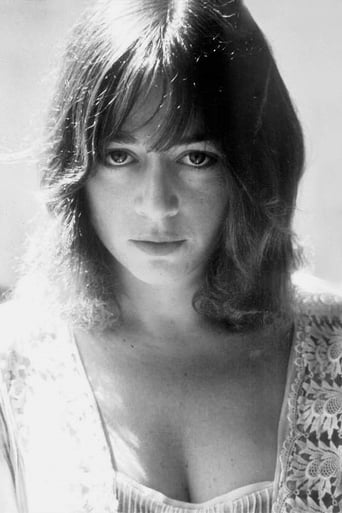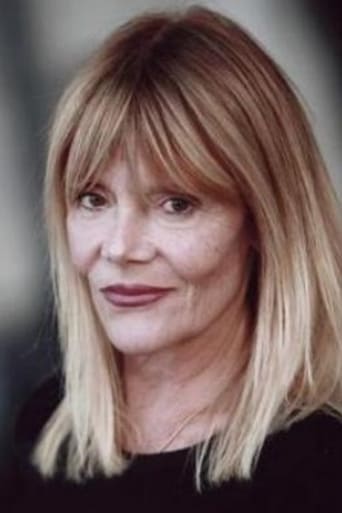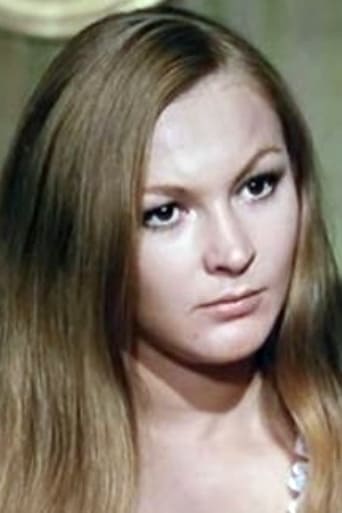Alicia
I love this movie so much
Stellead
Don't listen to the Hype. It's awful
Kirandeep Yoder
The joyful confection is coated in a sparkly gloss, bright enough to gleam from the darkest, most cynical corners.
Haven Kaycee
It is encouraging that the film ends so strongly.Otherwise, it wouldn't have been a particularly memorable film
Red-Barracuda
This is a Jess Franco film which seems to have garnered something of a good reputation amongst the vast array of his output. While I perused through the user reviews here I couldn't help but wonder if I had seen the same film, as from the plot synopsis offered by many of these I found there were several very key things I couldn't recall even happening on screen. I soon discovered that the reason for this is that there are three versions of this movie - the Spanish being the definitive cut it seems – and I saw the Italian variant which, like several other Franco films from the period had been turned into an adult film by way of some hardcore scenes being spliced into the flow. I think it would be only fair to guess that this version is not the best out there and compromises Franco's original vision somewhat.The story is about a woman who goes into a downward psychological spiral after the suicide of her sister. She subsequently sees visions of her dead sibling which leads her to go out and murder men.One of the chief differences between the versions is that in the Spanish one it is her dead father (played by Franco regular Howard Vernon) who she sees from beyond the grave, as opposed to her sister in the Italian version. This change seems to have been made principally to allow for the introduction of Lina Romay who, in her role as the sister, spends the whole time frolicking around naked and is at the centre of all the hardcore scenes too. These scenes, incidentally, are fairly half-heartedly executed and seem to be there simply as a means of selling the movie as an adult feature. However, unless I simply wasn't paying very good attention, this change also means that the whole mirror idea seems to have been more or less eradicated aside from a scene late on where it is smashed resulting in the breaking of the supernatural spell. Up to that point however, it seemed to me that all of this malarkey was going on in the head of the main actress, not playing out in an actual mirror! Despite these issues with the Italian version, this still made for interesting enough viewing. Despite its definite sexploitation angle, it is in essence quite a haunting tale. It's quite hard to reasonably categorize in actual fact because it has several feet in different sub-genres without truly focusing on one thread fully. I can only really comment on the version I have seen and going by that I couldn't put this in the upper bracket of Franco features; it's in the top half of his output though for sure. Like most of his films it has that rushed look and feel, while the production values are pretty limited. But it would seem that the Spanish version is the one to see if you want a proper reflection of this one's merits.
lonchaney20
Recently I watched the restored version of Jess Franco's Al otro lado del espejo (1973, known in English as The Other Side of the Mirror). Having previously watched it in an unsubtitled and dreadful looking bootleg, it goes without saying that this was a much richer experience, and gave me a deeper appreciation for Franco's screenplay (erroneously credited to his ex-wife, Nicole Guettard - perhaps for quota purposes?). The basic story concerns a jazz musician, Ana (beautifully played by Emma Cohen), who is plunged into depression after her possessive father (Franco favorite Howard Vernon) hangs himself on the eve of her wedding. She leaves her fiancée and throws herself into her music, racking up a number of lovers at the clubs she plays at, but time and again she is driven to murder them by the specter of her father, who appears to her in the mirror of the title. The film is somewhat atypical of the director's work from this period. It's as poetic and fiercely uncommercial as contemporaneous films like Lorna the Exorcist (1974) or A Virgin Among the Living Dead (1971), but it lacks the full-blooded erotica that made those films easier to sell. Instead the film remains a haunting showcase for its lead actress, whose rounded performance and large, soulful eyes have no equivalents in the Franco canon. Not surprisingly, she won that year's CEC Award for Best Actress.In terms of direction, the film is classic Franco, as the director conjures a lot from very little. Ana's journeys through the mirror are done simply but effectively, largely consisting of walks through a darkened hallway, but Franco's camera lingers on Cohen's face, allowing her haunted gaze to convince us. He achieves other simple yet memorable feats of imagination. The image of Ana's hanged father haunting her from various mirrors, recalling a hanged Paul Muller floating through the woods in A Virgin Among the Living Dead, makes a strong impression.This film, like the aforementioned Virgin and several other important titles, was unfortunately not commercial enough for its producer, Robert De Nesle. In order to recoup his investment, he paid Franco to create a pornographic variant of the film called Le miroir obscene. Now that the director's cut has been properly restored, hopefully the film will be acknowledged as the hidden gem of Spanish cinema that it is.
morrison-dylan-fan
With having enjoyed watching a double bill of writer/director Jess Franco's work during the IMDb's Horror board October Challenge of 2013,I started to search round for other near forgotten Franco titles,and was delighted to stumble upon one;which led to me looking in the mirror to find out who is the fairest one of all. The plot:Finding out that her sister is about to get married to Arturo Barbour, Marie Madeleine Whitman finds herself unable to cope with the knowledge that her sister is getting together with someone else,which leads to Marie killing herself.Finding her sisters body, Annette Whitman places all of the blame on herself,due to Annette having shown her love towards someone other than Marie. Sinking into a deep depression,Annette begins drinking heavily at a local jazz club.Taking a look at a mirror in her bed room one night,Annette is shocked to see the soul of Marie inside the mirror.Looking deep into the mirror,Annette is told by the soul of Marie that the only way they can connect again,is if Annette kills everyone who has fallen in love with her. View on the film: Whilst he does sometimes show himself to be a little bit too keen on the zoom- in, co-writer/ (along with Nicole Guettard) director and co-star Jess Franco gives the film an extremely distinctive saturated appearance,which allows for a wonderful feeling to gradually build over the "reality" of what Annette sees in the mirror.Expanding the original run time with a number of stylish sex scenes,Franco takes a scatter-shot approach to the scenes that allow them to feel like glimpse into the corners of Annette's mind,and for the scenes also to be rather steamy.Along with the saturated appearance,Franco also uses a number of smoothly done tracking shots to show the psychological fear break across Annette's face. Displaying a surprising hint of subtly,Franco and Nicole Guettard smartly never give a definitive answer over if the image of Marie in the mirror is real or imaginary,thanks to the writer's showing the sisters (possibly) incest relationship to be something which is buried deep with Annette's psych.Placing a good amount of the movie at a jazz bar,the writers match the notes from Adolfo Waitzman by making the men who die from Annette's killing spree to be flawed,but incredibly lively and very sincere in their feelings for Annette. Sadly restricted to the French-only cut of the movie, Lina Romay gives an excellent performance as Marie,with Romay softening the edges from the sex scenes by showing a real warmth in Marie's eyes over being reunited with Annette.Finding the unknown to be laying inside the mirror,the gorgeous Emma Cohen gives a fantastic performance as Annette,with Cohen giving Annette a strong,oddly innocent, sensual feel,as Cohen shows Annette to slow be unable to tell what is real and what is not,as she begins to look into the other side of the mirror.
chaos-rampant
Here is another of those elusive Franco films that in its proper context is neither horror, nor porn or sexploitation, in spite of the hardcore inserts, but wandering around urges. Now I appreciate Franco in the way you do with a friend or co-worker you have known forever. I appreciate him, in part, because of how familiar his flaws and habits. So I won't mollycoddle him or pretend in his face: he was often sloppy, charmless as a thinker and embarrassing in a number of ways. Whereas some fans read profundity in this film, for me all the stuff about mirrors, madness and theater as staged inner life are as sophomoric as it gets, for instance that whispers of a damaged mind will issue from a mirror. Let me say here that it's not the elements themselves, which others like Rivette, Resnais and Ruiz have used to similar effect, but the narrative distance they are placed away from the viewer, distance that leads up to them and away from.But I accept it as part of the experience of shared intuition that is possible with a good friend; Franco is worth knowing because, going past conscious narrative impositions, I can relax in a fluid fabric of images which he seems to spontaneously stir up from life as he walks through it. The more of his films I watch, the more I relax because I have shared in previous travels.It's all in the last scene here.Leading up to it we have obviously layered madness about a woman reliving guilt from her past, inserts of incestual cunnilingus and hardcore sex (in the Italian version I saw), and relaxed wandering around bars and later exotic Madeira. As a whole the film evokes Franco's films with Soledad, She Killed in Ecstasy and Eugenie. It is not as 'pure' as Female Vampire, nor on the other hand as testing.The idea, tremendously simple, is that a woman wanted to get married, but her beloved sister killed herself out of desperation and perhaps spurned love, and she carries this burden in unfulfilled affairs with men.The Spanish version without the inserts may flesh out the story a bit more, but story is not the main point, it's swimming across to where images acquire life of their own.In the last scene we have all this, the wandering, madness, and repressed emotion, coalesce together in a beautiful way as a bridal veil fluttering in the wind.





